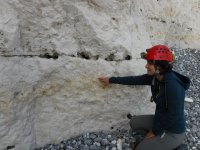By bottom I meant downstream end rather than depth
& The frog may well have come through a different (too small for a caver) route, rather than the sump - especially as it's capable of hopping upstream from wherever it entered.
I wonder how much of the pulsing is just caused by variance in rainfall intensity (& because it lands on one part of the catchment before getting to other bits) & how much by the different lengths of flooded passage in-between? A regulated flow of water into the top end will take some time to overcome the friction of a long flat stretch & reach the bottom end, the water coming in behind it will get there quicker, as it rides on the back of what is already moving, but then the outlet will overspill faster than the flow entering & it may return to a steady state that has to be overcome again...
& The frog may well have come through a different (too small for a caver) route, rather than the sump - especially as it's capable of hopping upstream from wherever it entered.
I wonder how much of the pulsing is just caused by variance in rainfall intensity (& because it lands on one part of the catchment before getting to other bits) & how much by the different lengths of flooded passage in-between? A regulated flow of water into the top end will take some time to overcome the friction of a long flat stretch & reach the bottom end, the water coming in behind it will get there quicker, as it rides on the back of what is already moving, but then the outlet will overspill faster than the flow entering & it may return to a steady state that has to be overcome again...




